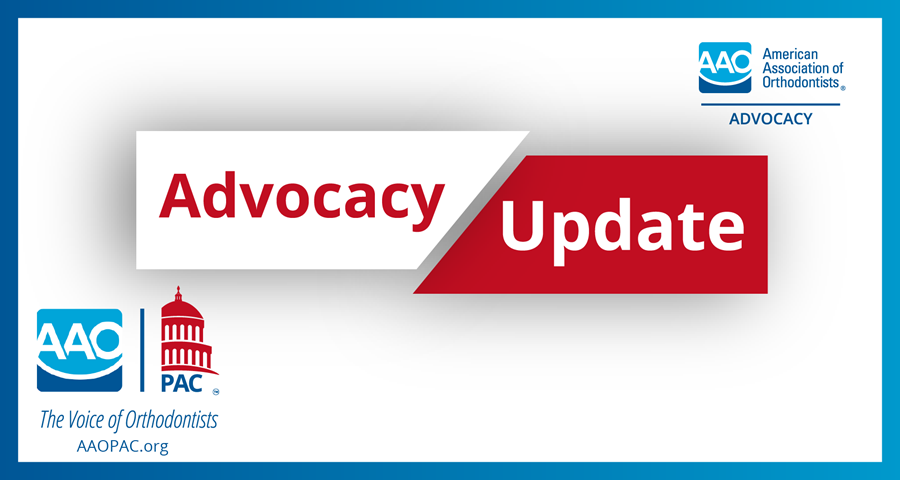With the new Administration in the White House and the beginning of the 119th Congress, the AAO Advocacy team is working closely with our Cozen O’Connor Public Strategies team (including Alex Campau and Meagan Foster), the AAO Council on Government Advocacy, the AAOPAC Board, and the award-winning AAO National Advocacy Network.
We are also working in coordination with our Organized Dentistry Coalition (ODC) – including other specialty and oral health organizations – to continue building the AAO brand in Washington, D.C. and grow our relationships for maximum influence on our AAO policy priorities. This work is done well when it is combined with two ongoing and meaningful inputs from AAO members: Using your voice through grassroots advocacy engagement and AAOPAC contributions that help to fuel our advocacy success in Washing, D.C. and in states throughout the country.
With the end of the 118th Congress on January 3, 2025, all legislation that was active during that two-year Congress went away and it does not carry over to the new 119th Congress. That means all priority legislation in the current Congress for the AAO will need to be introduced as new and then will be “live” for consideration in the Congressional legislative process until it is passed, or up until the 119th Congress ends in early January 2027.
The AAO’s 2025 Professional Advocacy Conference is just under a month away. Supported by Cozen O’Connor Public Strategies and the AAO Advocacy Team, AAO members will advocate for AAO priorities in Washington, D.C. at a time of significant transition in the nation’s capital. The Trump Administration, while still only a small operation that is staffing up, is making significant changes in its first few weeks in office. Congress, adjusting to its own transitions, is gearing up to pass large-scale legislation through a fast-track procedure called reconciliation.
Staff across the U.S. government are under significant pressure given the overlapping shakeups in Washington. Throughout election cycles and political changes in Washington, the AAO remains bipartisan and focused on public policy priorities that have an impact on AAO members and their patients.
Executive Branch
Presidential transitions are generally a time of controlled chaos. Political staff from the outgoing President are departing, and the new Administration is working to quickly staff up. For policy and political staff across Washington and beyond, it is a time of extreme angst as leaving staff try to find new jobs, and as those of the same party as the incoming President jostle for the positions and attempt to clear the administrative hurdles to working in the Executive Branch as quickly as possible.
In the background, career civil servants who remain in the government from one administration to the next need to adapt to new leadership and policy directions. The President is often focused on his day 1, week 1, month 1, and first 100-day agendas, and so there is an effort to move quickly.
That is all in a normal transition period. This one brings with it significantly more change than that.
President Trump has issued numerous Executive Orders (37 in the first week alone), which direct his agencies to take various actions and explore numerous policies, including support and international engagements, immigration, tariffs, the government workforce, and several other hot-button political issues that were prominent on the campaign trail as well. In addition to these policy instructions to the federal agencies, the Executive Branch sent a memo to agencies that temporarily paused certain federal funding streams and then rescinded that memo shortly thereafter.
While most government funding seems to have been restored, the agencies have been directed to look at the flow of federal dollars and turn them off in instances where they are in violation of the Executive Orders issues since January 20th. In some cases, funding is still disrupted. The legality of these actions is being reviewed in the courts.
Relatedly, the National Institutes of Health (NIH) under the Trump Administration has proposed new application requirements for grants and a policy that would limit their research funding for “indirect costs” to 15 percent of grants. Many grant recipients have raised concerns that this limit on “indirect costs” would render them unable to maintain their buildings and equipment and pay support staff and other overhead expenses. On February 10th, a federal judge issued a temporary restraining order blocking this policy.
A U.S. District Court will hear this case on February 21st. In the meantime, NIH grant recipients across the country (including AAO on behalf of its members) are weighing in with Congress and the Administration on the impact these cuts would have and the need to reverse course.
119th Congress
Control within the 119th Congress remains with Republicans in the House (with a very slim margin) and has flipped from Democratic to Republican control in the Senate. After 18 years, Senator Mitch McConnell has stepped down from his leadership role in the chamber, and Senator John Thune is the new Republican Leader and Senator John Barrasso the new Republican Whip (the number two leadership role in the Senate). Meanwhile, Democrats return Senator Chuck Schumer as Senate Democratic Leader (who has served in this position since 2017) and Senator Dick Durbin as Senate Democratic Whip (who has served in this position since 2005).
The Senate is charged with confirming President Trump’s nominees who require Senate confirmation. Some of President Trump’s picks for these roles are more conventional than others, but Senate Republicans are under tremendous pressure from the President to clear the nominations. As of February 11, the following officials have been cleared by the U.S. Senate:
- U.S. Secretary of the Treasury Scott Bessent
- U.S. Attorney General Pam Bondi
- U.S. Secretary of the Interior Doug Bergum
- U.S. Secretary of Veterans’ Affairs Doug Collins
- U.S. Secretary of Transportation Sean Duffy
- U.S. Secretary of Defense Pete Hegseth
- U.S. Secretary of Homeland Security Kristi Noem
- U.S. Central Intelligence Agency Director John Ratcliffe
- U.S. Secretary of State Marco Rubio
- U.S. Secretary of Housing and Urban Development Scott Turner
- U.S. Office of Management and Budget Director Russ Vought
- U.S. Secretary of Energy Chris Wright
- U.S. Environmental Protection Agency Administrator Lee Zeldin
In the House, Rep. Mike Johnson remains the Speaker, and he has a particularly challenging Republican Caucus to govern. Republicans currently have a narrow 218 to 215 margin in the U.S. House of Representatives. This majority will shrink to 217 if and when Rep. Elise Stefanik (R-NY) is confirmed as U.S. Ambassador to the United Nations. However, Republicans are expected the fill their three House vacancies when special elections are held in Spring 2025.
Compounding these narrow margins are the ideological fractions within the House Republican Caucus. The conservative House Freedom Caucus is expected to exert pressure on House Republican Leadership to ensure that any legislation brought to a vote is sufficiently conservative. However, House Republican leadership cannot afford to lose the support of moderate Republican members that narrowly won their 2024 House races.
The House Democratic Caucus is led by second-term Democratic Leader Hakeem Jeffries, second-term Democratic Whip Katherine Clark, and second-term Democratic Caucus Chairman Pete Aguilar. Moreover, Speaker Emerita Nancy Pelosi continues to hold significant informal influence over the Caucus’s activities. House Democrats are expected to oppose the major Congressional Republican legislative initiatives and force these initiatives to be passed exclusively with House Republican votes.
Congress has big legislative goals in the year ahead. The Tax Cuts and Jobs Act, which passed during President Trump’s first term, includes many tax cuts that expire at the end of 2025, things like the 199A Deduction (i.e., deduction for pass-through business income), limitations on losses for non-corporate taxpayers, and business expensing.
Congressional Republicans are hoping to use a fast-track procedure called budget reconciliation to extend these tax cuts legislatively, as well as address immigration issues that are a top priority for President Trump, and defense spending. There are many Republicans who believe the increased spending and reduced federal revenue (due to tax cuts) needs to be offset with spending cuts, which has sent Republican committees into an all-hands-on-deck effort to find federal spending to cut, which in turn has sent Washington into a tailspin as those who rely on federal funding try to ensure they are not on the chopping board.
The spending cuts that have been included in this discussion range from converting the Medicaid program into per-capita-caps, to limiting federal health program eligibility based on citizenship, to repealing green energy tax credits, to ending the employee retention tax credit, to eliminating the deduction of interest on student loans, to codifying and increasing tariffs on China, to adding work requirements to federal welfare programs, to even eliminating the home mortgage interest deduction.
Any of these policies that would cut federal spending and benefits face an uphill path given the very slim majorities for Republicans, especially in the House, and a near guarantee that no Democrats will support the legislation.
Amidst this storm of activity, AAO continues to weigh in with Members of Congress and the Administration on the importance of better federal policies for student loans, opportunities for Congress to make it easier for families to save for their future health care needs, and the significant patient harm that mail-order orthodontic treatment models can potentially cause.
As the AAO focuses on advancing our priorities in Washington, DC and throughout the states, please help support AAO Advocacy priorities now by making your gift celebrating 125 years of AAO in 2025. It only takes a few minutes to complete your contribution now at AAOPAC.org, using your e-mail address associated with your AAO membership.
AAOPAC is helping to fuel our advocacy success not only in Washington, D.C. but in states throughout the country as well. Our AAOPAC Pillars of Giving are working and the AAO’s advocacy influence continues to grow through AAO member grassroots engagement. Your grassroots voice and AAOPAC support make all the difference!


